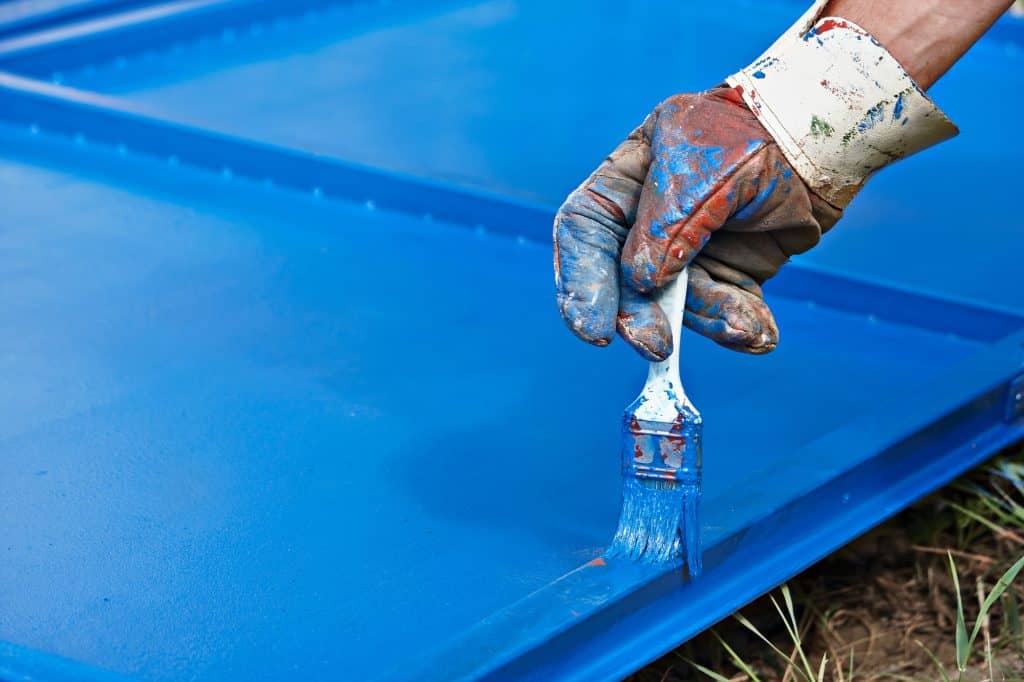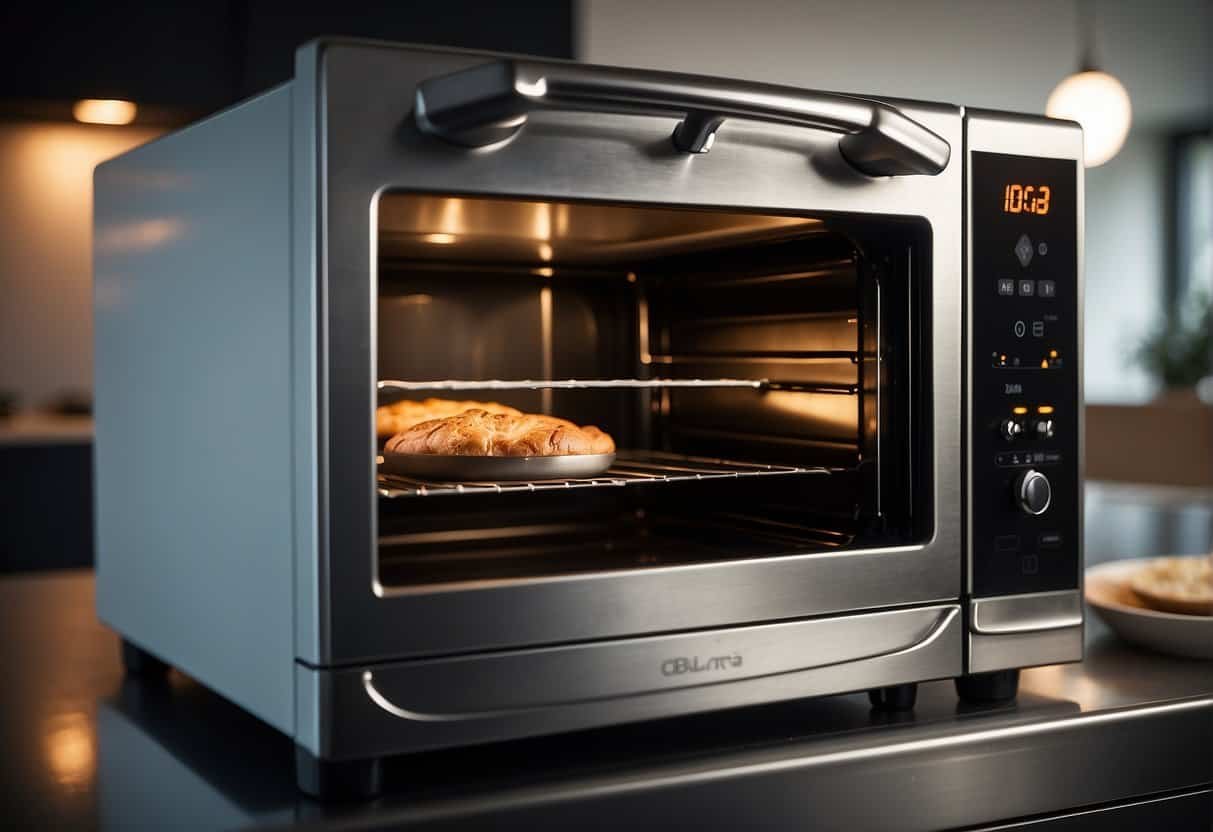Table of Contents
When working with untreated metal, it’s best to apply a coat of self-etching primer for corrosion protection. But can you paint over it?
You can paint over self-etching primer once it has dried and cured. However, most manufacturers recommend applying a layer of regular primer on top to provide a better painting surface. Sanding the self-etching primer layer can also improve paint adhesion.
Read further to discover everything you need to know about self-etching primer.
Can You Paint Directly Over Self-Etching Primer?
If you’re restoring an old metal or fiberglass object, you’ve probably removed the old paint to uncover the raw material. You’ve also probably heard that self-etching primers will protect the metal, but can you paint the metal directly over this primer?
You can paint directly over self-etching primer only if the manufacturer advises that you can do it. However, applying a regular primer layer on top prevents the acids from interfering with subsequent layers and helps the paint adhere correctly.
Self-etching primer contains phosphoric acid and zinc. After applying a coat of self-etching primer to bare metal or fiberglass, the phosphoric acid corrodes the metal.
It seeps into it, allowing the zinc particles to release and form a corrosion-resistant barrier. (source: SpringerLink and National Library of Medicine)
If you don’t apply a regular primer on top of the self-etching primer layer to seal it, the acids will eat away at the paint, causing it to splinter and flake.

Regular primer increases the metal’s passivity by forming an oxidized layer to seal it and provide additional rust protection. Primers typically contain titanium, nickel, tantalum, or aluminum, which are excellent insulators. (sources: ScienceDirect and Mindat)
Below is some more information on what (and what not) to use over a self-etching primer layer:
- Enamel Paint. You can apply enamel paint over self-etching primer if the manufacturer’s instructions say you can. However, with most self-etching primers, you need to apply a layer of primer first.
- Urethane Primer. Urethane primer works well over self-etching primer. It creates an excellent adhesive surface for subsequent paint layers and acts as an effective shield against the acids in the self-etching primer.
- Epoxy Primer. Unless the manufacturer recommends it, you should avoid using an epoxy primer over a self-etching primer.
The self-etching primer’s high acid content can prevent the epoxy primer layer from drying completely, resulting in an uneven paint job. (source: Corrosionpedia)
Before applying your self-etching primer layer, you must ensure that the metal or fiberglass is well-prepared. To do that, follow these steps:
Clean the metal or fiberglass surface well. Dust and dirt can negatively affect how the self-etching primer works. Removing surface dust and dirt with a dry cloth is vital. To ensure the surface is completely clean, apply some mineral spirits and allow it to dry.
Sand the surface if it’s uneven. If you’re working with old metal or fiberglass, the surface might be uneven, interfering with the self-etching primer’s effectiveness. Gently sanding the surface with low-grit sandpaper can address this issue.
Wet the sandpaper for a smooth and uniform finish. If the metal or fiberglass surface is significantly uneven, consider wetting the sandpaper to lubricate the surface as you sand it. This method works well to remove tiny dirt particles and helps prevent deep scratch formation.
Clean the surface after sanding. After sanding the metal or fiberglass, wipe it with a dry cloth to remove any excess dust that could interfere with the self-etching primer. You could wipe the surface with some mineral spirits for peace of mind. (source: The Spruce)
With most self-etching primer brands, one layer is usually enough. However, if you’re not happy with the surface’s texture after applying the first coat, using two to three additional coats can create a smoother surface. (source: Rust-Oleum)
Is It Possible To Paint Over Rustoleum Self-Etching Primer?
Rustoleum Self-Etching Primer is a wonderful product as it allows you to spray the product on from any angle. Can you paint directly over it, though?
It is not possible to paint over Rustoleum Self-Etching Primer until you have applied a topcoat. According to the product’s technical data, you should apply two to three thin coats and sand the surface before applying the paint and a topcoat.
After each layer of Rustoleum Self-Etching Primer, you should wait at least two minutes for it to dry before applying the next one. Before sanding the surface, you need to wait for three to four hours. (source: Rust-Oleum)
Does Paint Stick to Etching Primer Anyway?
In the previous section, I mentioned it’s best to use a layer of regular primer between the self-etching primer and paint. But doesn’t paint stick to etching primer, anyway?
Paint sticks to etching primer, but without a primer layer, the etching primer’s acids will gradually destroy the paint, causing it to flake and look uneven.
Also, there are a few other reasons you should use a primer between a self-etching primer and paint.
The first is that self-etching primer doesn’t form a suitable paint surface.
It’s rare for a manufacturer to state that you can apply paint directly over the self-etching primer layer. Its primary function is to prevent rust, and most brands don’t form a smooth surface conducive to even painting.
With its high phosphoric acid content, self-etching primer corrodes and readily soaks into the underlying metal or fiberglass. It doesn’t change the metal or fiberglass slippery texture much, and you need a primer layer for the paint to adhere. (source: c&en)
Secondly, a primer effectively seals the self-etching primer.
It also prevents the acids from interfering with subsequent paint layers and contains ingredients that provide an ideal painting surface.
Self-etching primers are great at preventing moisture from seeping into the underlying metal, but primers do well at preventing moisture from the metal from affecting the paint layers.
Applying a primer is time-consuming but worth it as it usually results in a professional-looking finish. (source: Dulux Protective Coatings)
Last but not least, the primer prevents the paint from soaking into the metal.
Specifically, the primer forms a strong barrier between the self-etching primer and paint layers. If you don’t apply a primer coat, the paint may soak into the underlying self-etching primer layer and metal or fiberglass, making your paint job look dull and uneven.
When the paint interacts with the chemicals in the self-etching primer, it may alter its color, resulting in a patchy and unattractive paint job. (sources: Paint Topics and Seymour Paint)
Can You Use a Self-Etching Primer Over Paint?
Do you have a painted fiberglass or metal object you want to repaint or treat with self-etching primer? If so, you might wonder if it’s okay to use self-etching primer over paint.
You cannot use self-etching primer over paint because the acid will not form a strong chemical bond with the raw metal, and the zinc will not create a protective layer.
One of the self-etching primers’ main aims is to prevent rust. It won’t be rust-resistant if the zinc can’t create a solid, non-corrosive barrier over the raw metal.
Applying self-etching primer over paint also means the acid will gradually eat away at the underlying paint, resulting in an unevenly painted object. Check for the best washable matt.

How Long Before You Can Paint Over a Self-Etching Primer?
After applying your self-etching primer layer, you’re probably eager for the fun part — the painting! So, how long should you wait before starting the painting process?
You can paint over the self-etching primer layer once it has completely dried. Consult the product label to determine how long you need to wait before applying paint (usually 30 minutes).
Self-etching primer starts to work immediately after you apply it. However, you need to wait until it has thoroughly dried for it to form an anti-rust barrier.
It’s vital to allow the self-etching primer layer time to bond chemically with the underlying metal. Applying a regular primer or paint when the self-etching primer layer hasn’t yet cured defeats the purpose of using it. Your metal or fiberglass may not have the desired corrosion-resistant properties.
Self-etching primers have a shorter curing time than regular primers because they contain very few solids, resulting in a low film build-up and a thin layer. (source: AutoMobilia)
Below is a helpful guide to drying wait times after applying self-etching primer:
- Wait at least two minutes between coat applications. The wait time between self-etching primer coats is short due to their thin consistency.
- Wait at least four hours after application before sanding. If you want to sand the self-etching primer layer, it’s best to wait four hours to ensure it has cured thoroughly.
- Wait 30 minutes before applying the primer. After applying your self-etching primer layers, allow the final layer to dry for half an hour before applying the primer.
- Wait at least 30 minutes before painting. If you’re using a self-etching primer brand that states you can paint directly onto it without a primer layer, wait for at least 30 minutes before painting.
Not allowing the primer layers to dry can result in uneven paint, streaking, bubble formation, and flaking. - Wait another 30 minutes before applying a topcoat. After applying your paint layers, allow the paint to dry for 30 minutes before applying the topcoat.
The above is only a general guide. The manufacturer’s instructions should override them if the latter differs. How long your self-etching primer takes to dry can also depend on the following factors:
- Temperature. The ideal drying temperature for self-etching primer is 21.1°C (70°F), though cooler temperatures can speed up the drying process.
- Humidity. If your object is in a very humid environment, it will take longer to cure than in low-humidity conditions.
A 50% humidity level is perfect for self-etching primer, and you can decrease the humidity and temperature in the drying place by putting on a fan or air conditioning. - Coat thickness. Applying several thin primer layers is better than a couple of thick ones, as thin coats dry faster.
Do You Have To Sand Self-Etching Primer Before Painting?
Some self-etching primer labels mention that you don’t have to sand before painting, while others state otherwise. So, which is it?
You have to sand self-etching primer before painting as it provides a better adhesive surface for the subsequent primer and paint layers. The resulting paint job will look smooth and uniform.
The best time to sand the self-etching primer layer is within 24 hours of applying it and once it has dried completely (this usually takes four hours).
What Primer or Paint Should I Use Over Self-Etching Primer?
Now that you know how long to wait after applying your self-etching primer layer before painting, what are the most suitable primer or paint products to use?
You should use a urethane primer over a self-etching primer as it creates an excellent adhesive surface for various paint types. Oil-based paint works well on metal or fiberglass and creates a shiny finish, but you should remember to apply a topcoat.
U-Pol Products Urethane Primer Filler from Amazon.com is a fantastic primer to use over your self-etching primer coat, as it helps to create a level surface for paint application.
Oil-based paints are more expensive than water-based ones, but their high plant oil and resin content create a rigid and weather-resistant finish after curing. If you’re using your metal object indoors, water-based paint could work well, but it won’t provide a high-sheen result.
If you have a fiberglass object, consider using acrylic paint because it adheres well to the surface and isn’t prone to cracking and flaking.
After your paint layers have dried, applying a topcoat is essential. This paint layer may seem unnecessary, but it offers the following benefits:
- Prevents scratching and chipping
- Provides additional shine to the paint
- Most topcoats provide UV protection
- Provides additional paint longevity
(source: Corrosionpedia)
An excellent topcoat for metal and fiberglass is the Rust-Oleum Universal Clear Topcoat Spray from Amazon.com. It functions well as a topcoat for most materials but adheres effectively to fiberglass and metal.
A benefit of buying this product is you could use it as a topcoat for something else if you have any leftovers.
I hope you have found this guide useful and that it has answered your questions about using self-etching primers!












